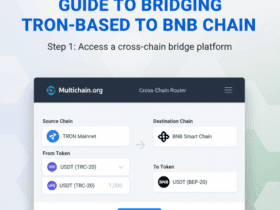In this article, I will guide you on how to connect a hardware wallet to a bridging aggregator. Using a hardware wallet ensures your crypto assets remain secure while enabling seamless cross-chain transfers.
I’ll walk you through the step-by-step process, highlight essential safety measures, and explain how to confirm and monitor transactions for a smooth, risk-free bridging experience.
What is a Bridging Aggregator?
Bridging aggregators are interfaces that combine several blockchain bridges into one. They allow users to transfer assets from one blockchain to another seamlessly without having to deal with each bridge protocol individually.
Examples are Multichain, Allbridge, and Celer cBridge. Aside from consolidating multiple blockchain bridges into one interface, aggregators optimize fee structures, reduce transaction times, and provide constant updates on liquidity. Cross-chain transactions are executed securely through the use of hardware wallets.
How To Connect Hardware Wallet To Bridging Aggregator
Multichain Connection Steps for a Hardware Wallet: Essential Points

Setup for the Hardware Wallet
- Install necessary apps of the specific blockchains and update the necessary apps’ firmware.
- Unlock and connect through associated software (Ledger Live and Trezor Suite).
Access Multichain
- Go to the site multichain.org and select Connect Wallet.
Select Wallet Type
- Please select either Ledger or Trezor and follow the steps that will pop up.
Authorize Device Connection
- Run the relevant blockchain application on the hardware wallet.
- Approve for the connection to be made. Rest assured, the private keys remain on the hardware wallet.
Select Source and Destination Networks
- Select the source and destination blockchains.
Specify Token, Amount and Network Fee
- Select the token, specify the amount, and crosscheck the fees, as well as the estimated time of processing.
Verify Transaction
- Crosscheck the token, amount, and the provided destination address.
Device Authorization for Transaction Signing
- Sign the document on the hardware wallet after confirming all of the stated details.
Selecting Blockchains and Tokens
Choosing Source and Destination Blockchains
Use the blockchain that currently holds your tokens as the source and select the blockchain where you want them moved as the target.
Selecting Supported Tokens
Select the token you desire to bridge and ensure it is supported on both the source and the destination blockchains.
Inputting the Amount and Checking Estimated Fees
Bridging tokens will incur transaction costs. Enter the token amount and evaluate the fees presented by the aggregator before proceeding.
Approval Process on the Hardware Wallet for Security
To maintain the offline security of private keys, verify and approve the transcend directly on your hardware wallet.
Confirming and Executing Transactions
Validating Every Transaction’s Step Carefully
Make sure all steps including the token, amount, address, and network are correct before confirming the transaction to avoid errors.
Transaction Acceptance in the Hardware Wallet
Make sure to approve the transaction on the hardware wallet to ensure private keys remain offline and shield the transfer from online threats.
Watching the Progress on the Aggregator’s Interface
Check the aggregator’s interface for progress on the transaction. It may take several minutes, especially during peak hours and network congestion.
Tips for Safe Bridging
Using Official Websites Only
The official aggregator website must always be accessed to avoid phishing attacks and scams endangering your funds and personal information.
Avoiding Public Wi-Fi Connections
Do not connect your hardware wallet to public Wi-Fi. Unsecured networks can expose your device to hackers and malware.
Testing with Small Amounts Before Larger Transfers
To ensure the process works, begin with small token amounts, then bridge larger sums of cryptocurrency after successive small transfers.
General Safety Precautions for Hardware Wallet Use
Safeguard your hardware wallet and recovery seed. Keep software updated. Do not share private keys and always verify transactions pre-approval.
Conclusion
In conclusion, connecting a hardware wallet to a bridging aggregator facilitates secure cross-chain transactions. You secure full control over your assets by selecting the correct blockchain, verifying tokens, and confirming transactions on your hardware wallet.
Always use official platforms, SMS verification, the correct addresses, and start with small transactions first. This method guarantees convenience while strong security, reducing the risks involving bridging operations.
FAQ
Use the aggregator’s “Connect Wallet” option and select your hardware device.
Always use official sites, verify transactions, and start with small amounts.
Approve all details directly on your hardware wallet before execution.












Got a Questions?
Find us on Socials or Contact us and we’ll get back to you as soon as possible.